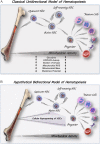Ex vivo HSC expansion challenges the paradigm of unidirectional human hematopoiesis
- PMID: 31199002
- PMCID: PMC7216880
- DOI: 10.1111/nyas.14133
Ex vivo HSC expansion challenges the paradigm of unidirectional human hematopoiesis
Abstract
Understanding mechanisms that determine the behavior of human hematopoietic stem cells (HSCs) is essential for developing novel strategies to expand ex vivo the number of fully functional HSCs. In this review, we focus on the complex interplay between intrinsic mechanisms regulated by transcriptional and mitochondrial networks and extrinsic signals imposed by the bone marrow microenvironment, which in concert regulate the balance between HSC self-renewal and differentiation. Such integrated signaling mechanisms that dictate the fate of HSCs in vivo must be recapitulated ex vivo to achieve successful expansion of clinically relevant HSCs. We also highlight some of the most recent ex vivo HSC expansion strategies that have currently entered clinical development. Finally, based on the evidence reviewed here and lessons learned from ex vivo HSC expansion, we raise some critical questions regarding HSC fate and the cellular plasticity of hematopoietic cells that challenge the unidirectional model of human hematopoiesis.
Keywords: BM niches; HSCs; ex vivo expansion; mitochondrial network.
© 2019 The Authors. Annals of the New York Academy of Sciences published by Wiley Periodicals, Inc. on behalf of New York Academy of Sciences.
Conflict of interest statement
The authors declare no competing interests.
Figures

Similar articles
-
A role for niches in hematopoietic cell development.Hematology. 2005 Jun;10(3):247-53. doi: 10.1080/10245330500067249. Hematology. 2005. PMID: 16019473
-
Rapamycin enhances long-term hematopoietic reconstitution of ex vivo expanded mouse hematopoietic stem cells by inhibiting senescence.Transplantation. 2014 Jan 15;97(1):20-9. doi: 10.1097/TP.0b013e3182a7fcf8. Transplantation. 2014. PMID: 24092377 Free PMC article.
-
RARgamma is critical for maintaining a balance between hematopoietic stem cell self-renewal and differentiation.J Exp Med. 2006 May 15;203(5):1283-93. doi: 10.1084/jem.20052105. Epub 2006 May 8. J Exp Med. 2006. PMID: 16682494 Free PMC article.
-
Ex vivo expansion of hematopoietic stem cells.Exp Cell Res. 2023 Jun 1;427(1):113599. doi: 10.1016/j.yexcr.2023.113599. Epub 2023 Apr 13. Exp Cell Res. 2023. PMID: 37061173 Review.
-
Hematopoietic Stem Cells, Their Niche, and the Concept of Co-Culture Systems: A Critical Review.J Stem Cells. 2015;10(1):13-31. J Stem Cells. 2015. PMID: 26665935 Review.
Cited by
-
Limited Mitochondrial Activity Coupled With Strong Expression of CD34, CD90 and EPCR Determines the Functional Fitness of ex vivo Expanded Human Hematopoietic Stem Cells.Front Cell Dev Biol. 2020 Dec 15;8:592348. doi: 10.3389/fcell.2020.592348. eCollection 2020. Front Cell Dev Biol. 2020. PMID: 33384995 Free PMC article.
-
Effect of Small Molecule on ex vivo Expansion of Cord Blood Hematopoietic Stem Cells: A Concise Review.Front Cell Dev Biol. 2021 Apr 9;9:649115. doi: 10.3389/fcell.2021.649115. eCollection 2021. Front Cell Dev Biol. 2021. PMID: 33898442 Free PMC article. Review.
-
Secreted factors from mouse embryonic fibroblasts maintain repopulating function of single cultured hematopoietic stem cells.Haematologica. 2021 Oct 1;106(10):2633-2640. doi: 10.3324/haematol.2020.249102. Haematologica. 2021. PMID: 33543864 Free PMC article.
-
Microplastics dampen the self-renewal of hematopoietic stem cells by disrupting the gut microbiota-hypoxanthine-Wnt axis.Cell Discov. 2024 Mar 29;10(1):35. doi: 10.1038/s41421-024-00665-0. Cell Discov. 2024. PMID: 38548771 Free PMC article.
-
The EHA Research Roadmap: Normal Hematopoiesis.Hemasphere. 2021 Nov 30;5(12):e669. doi: 10.1097/HS9.0000000000000669. eCollection 2021 Dec. Hemasphere. 2021. PMID: 34853826 Free PMC article. No abstract available.
References
-
- Jacobsen, S.E.W. & Nerlov C.. 2019. Haematopoiesis in the era of advanced single‐cell technologies. Nat. Cell Biol. 21: 2–8. - PubMed
Publication types
MeSH terms
LinkOut - more resources
Full Text Sources
Medical

